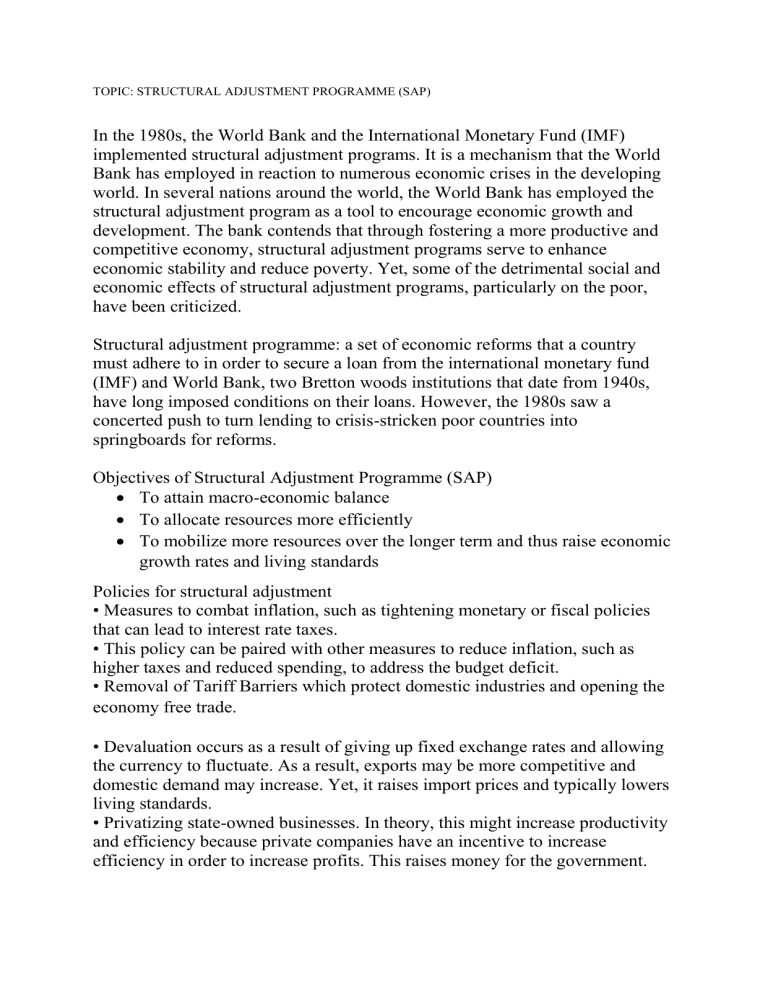
TOPIC: STRUCTURAL ADJUSTMENT PROGRAMME (SAP) In the 1980s, the World Bank and the International Monetary Fund (IMF) implemented structural adjustment programs. It is a mechanism that the World Bank has employed in reaction to numerous economic crises in the developing world. In several nations around the world, the World Bank has employed the structural adjustment program as a tool to encourage economic growth and development. The bank contends that through fostering a more productive and competitive economy, structural adjustment programs serve to enhance economic stability and reduce poverty. Yet, some of the detrimental social and economic effects of structural adjustment programs, particularly on the poor, have been criticized. Structural adjustment programme: a set of economic reforms that a country must adhere to in order to secure a loan from the international monetary fund (IMF) and World Bank, two Bretton woods institutions that date from 1940s, have long imposed conditions on their loans. However, the 1980s saw a concerted push to turn lending to crisis-stricken poor countries into springboards for reforms. Objectives of Structural Adjustment Programme (SAP) To attain macro-economic balance To allocate resources more efficiently To mobilize more resources over the longer term and thus raise economic growth rates and living standards Policies for structural adjustment • Measures to combat inflation, such as tightening monetary or fiscal policies that can lead to interest rate taxes. • This policy can be paired with other measures to reduce inflation, such as higher taxes and reduced spending, to address the budget deficit. • Removal of Tariff Barriers which protect domestic industries and opening the economy free trade. • Devaluation occurs as a result of giving up fixed exchange rates and allowing the currency to fluctuate. As a result, exports may be more competitive and domestic demand may increase. Yet, it raises import prices and typically lowers living standards. • Privatizing state-owned businesses. In theory, this might increase productivity and efficiency because private companies have an incentive to increase efficiency in order to increase profits. This raises money for the government. • Eliminating food subsidies, which could skew the market, cause an oversupply, and impede economic diversification toward a more industrialized economy. • Cutting back on bureaucracy and red tape. • Sealing off tax loopholes and cutting down on corruption. • Market deregulation to promote competition and attract more businesses to the industry. CRITICIMS OF STRUCTURAL ADJUSTMENT PROGRAMME 1. Information handling policies. Increased taxes and interest rates frequently result in a recession and rising unemployment. They frequently cause immediate pain. This is possibly the main cause of structural adjustment's widespread unpopularity in the nations where it is practiced. We could argue that dealing with inflation is vital to protect structural adjustment. If not addressed, inflation might only worsen, making a future adjustment even more difficult. The agony is frequently very fleeting, too. Low inflation, if addressed, allows for a time of economic stability. 2. The poorest segment of society is affected by spending decreases. Spending reductions on crucial welfare services like education and healthcare have frequently been the result of structural adjustment. It's common to think of structural adjustment as increasing inequality. Spending reductions don't have to affect the most vulnerable groups in society. Military spending could be the target of spending reductions, and/or the budget could be balanced by raising taxes on affluent earnings. Through tools like Poverty Reduction Strategy Papers (PRSPs), the IMF has recently urged structural adjustment strategies to include poverty reduction. Critics counter that the fundamental policies still apply despite the new aims for eliminating poverty. 3. A reduction in national sovereignty. The IMF's policies must be followed in order to avoid paying a steep financial fine. This provides foreign organizations considerable sway over important economic concerns in emerging economies. 4. A rise in inequality. Policies for structural adjustment have frequently shown a tendency to increase inequality. For instance, privatization has frequently benefited a small, wealthy elite (such as in Russia in 1995) but not a larger population. 5. Disregard social advantages. The privatization of important public utilities, such as water in Bolivia, has resulted in higher pricing for a crucial good. Market incentives may not be as significant when an industry performs a critical social welfare role. Nonetheless, even when not necessary, structural adjustment measures frequently adhered to a certain philosophy. 6. Unemployment. At least temporarily, tighter fiscal restrictions and inflation control have resulted in more unemployment and slower economic growth. 7. Ignoring social development. Governments frequently slash welfare spending programs that help the most vulnerable people in society in order to achieve fiscal requirements. 8. Often, diversification is hampered by free trade. By selling raw materials, developing economies frequently enjoy a comparative advantage. Yet, this inhibits the economy from diversifying. Developing countries demand free trade for their goods, but wealthy countries frequently impose taxes on agricultural exports, making the situation worse.


